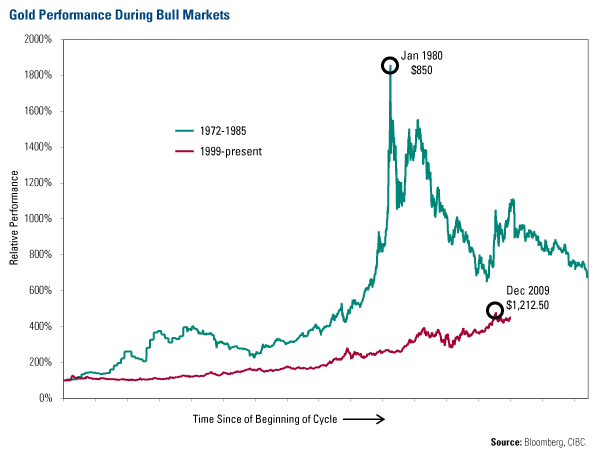Frank Holmes: What Gold Bubble?
You think Gold is a bubble? Take a look at the chart of Gold’s performance this bull market against the 1970s. There isn’t any comparison.
http://www.usfunds.com/investor-resources/frank-talk/?i=2751
Gold is getting a lot of attention these days. It’s all over the media, the backlog to purchase gold coins from the U.S. Mint is years long, and one gold exchange company even ponied up for a Super Bowl ad.
Many point to this and shout “Bubble!” Gold has risen too far too fast, they say, and soon the euphoria will give way to despair. We’ve been hearing this since February of last year, when gold was trading around $900. That’s more than 25 percent below where it is today.
Why didn’t the gold “bubble” burst? It could be because there isn’t a gold bubble.
The chart below compares the price performance of gold bullion during the 1970s bull market (green line) to the current price trend (red). As you can see, the price line since the start of 1999, when gold was trading just under $300, has been far less volatile than during the earlier period.

Gold remains as a safe haven during times of economic uncertainty – in the 1970s, double-digit inflation rapidly eroded wealth, and these days there is a lingering fear of higher inflation as the federal government piles more debt onto its already groaning balance sheets.
But a key difference is that gold has gained stature as a legitimate asset class for investors. During the 1970s runup, investment demand peaked around 27 million ounces, about half of what it is today. Contributing to this demand are new investment vehicles, including gold-oriented mutual funds and bullion-backed ETFs, both of which have made it easier for investors to allocate a portion of their portfolios to the yellow metal.
We also have greater affluence in the developing world, where people have traditionally turned to gold to store their wealth. Central banks in these countries, most notably China and India, have built up their gold holdings as a way to diversify their foreign reserves away from the dollar and other paper currencies.
The 1990s dot-com era was a bubble, and likewise the 2000s housing market. But gold? We don’t think so.
Investments in natural resources, emerging markets and infrastructure are subject to distinct risks as described in the funds’ prospectus.
[ad#New Text Ad]




